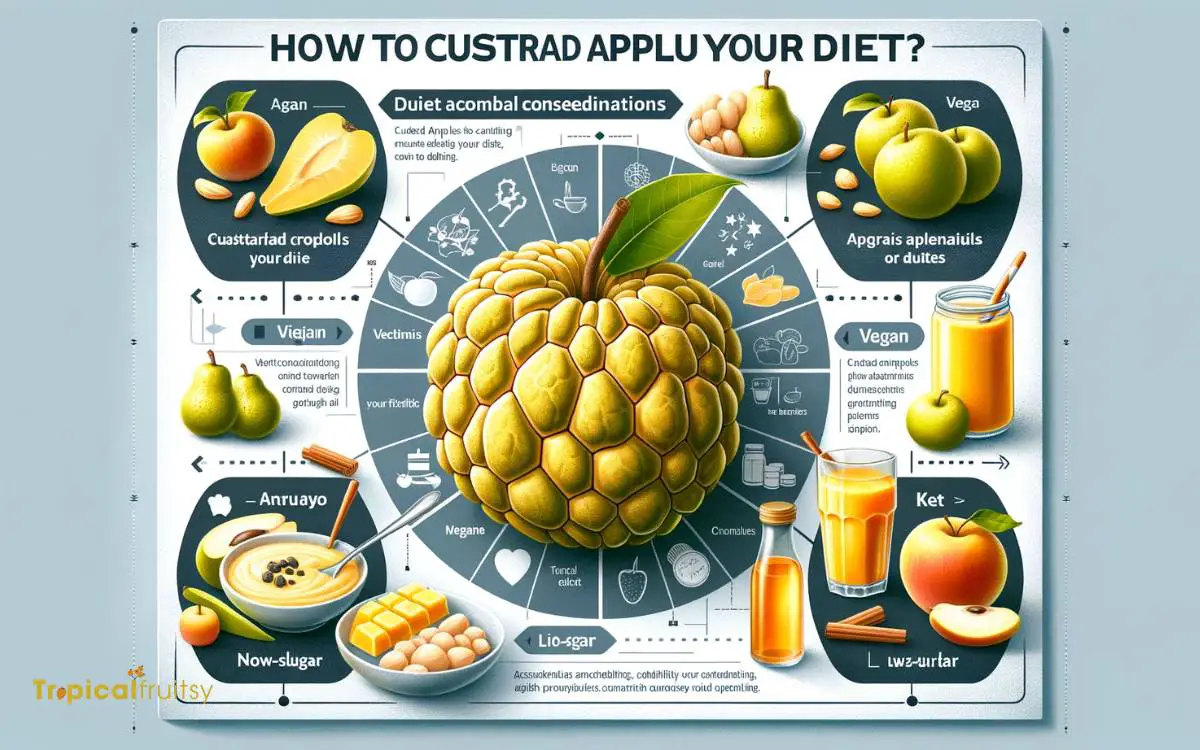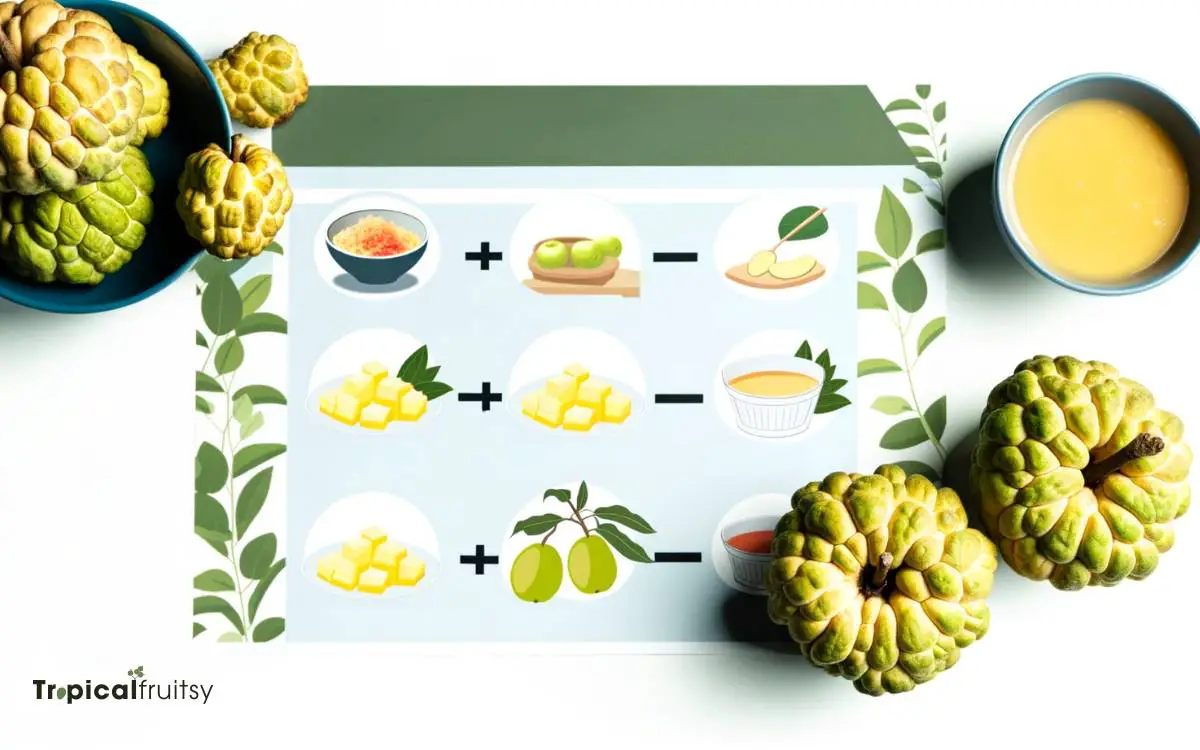How Many Custard Apple to Eat in a Day? Explore!
Did you know that an average custard apple contains about 94 calories?
As I’ve become more health-conscious, I’ve learned it’s not just about counting calories but also understanding the nutritional value of what I eat.
Let’s talk about the custard apple, a fruit I’ve found both delicious and intriguing. Its rich nutritional profile includes a good dose of fiber, vitamins, and minerals.
I’ve discovered that while it offers numerous health benefits, it’s important to consume it in moderation. I usually aim for one custard apple a day to strike a balance between reaping its advantages and avoiding overconsumption risks.
The key is understanding the recommended daily intake and how it fits into my dietary needs.
Let’s explore how to incorporate this sweet, creamy fruit into our diets effectively and what to keep in mind while enjoying it.

Key Takeaway
Recommended Daily Intake of Custard Apples
| Age Group | Recommended Daily Intake |
|---|---|
| Children (2-6 years) | 1/2 to 1 custard apple |
| Children (7-18 years) | 1 to 1.5 custard apples |
| Adults | 1 to 2 custard apples |
| Pregnant Women | 1 to 1.5 custard apples |
| Lactating Women | 1.5 to 2 custard apples |
The Nutritional Profile

Understanding the nutritional profile of custard apples is crucial to determining how many I should consume daily. Each custard apple is a powerhouse of essential nutrients.
They’re rich in dietary fiber, which aids in digestion and helps maintain a healthy gut. They also pack a punch of vitamin C, important for immune system function, and antioxidants, which protect my body from harmful free radicals.
Custard apples are also a good source of potassium, necessary for heart health, and magnesium, which is vital for muscle and nerve function.
However, they’re relatively high in natural sugars and calories, which means I’ve got to be mindful of my intake. Balancing these nutritional facts, I aim for moderation.
Health Benefits Overview

Understanding the health benefits of custard apples requires a closer look at their rich nutrient content.
I’ll examine how the vitamins, minerals, and antioxidants found in this fruit could contribute to disease prevention and overall health maintenance.
It’s important to consider both the potential advantages and the limitations of incorporating custard apples into a daily diet.
Nutrient Content Analysis
Analyzing the nutrient content of custard apples, I’ve found they’re packed with essential vitamins and minerals that can offer numerous health benefits. Rich in vitamin C, custard apples help bolster the immune system.
They’re also a good source of dietary fiber, which aids in digestion and may contribute to a feeling of fullness, potentially supporting weight management.
The presence of magnesium and potassium contributes to heart health by regulating blood pressure levels.
Moreover, custard apples contain antioxidants like vitamin A, which plays a role in vision health and skin integrity.
It’s important to note that while these fruits are nutrient-dense, they also contain sugars. Thus, moderation is key to reaping their health benefits without consuming excessive calories.
Disease Prevention Potential
I’ve discovered that incorporating custard apples into your diet can play a significant role in disease prevention, thanks to their array of health-promoting nutrients.
Packed with antioxidants, custard apples help combat oxidative stress, which is linked to chronic diseases like cancer and heart disease.
They’re also rich in dietary fiber, which supports digestive health and may reduce the risk of colorectal cancer.
The vitamin C content bolsters the immune system, while the potassium helps maintain healthy blood pressure levels.
It’s important to note that while custard apples have these potential benefits, they should be part of a varied diet.
Overconsumption of any single food can lead to imbalances and isn’t recommended. Balance and moderation are key to harnessing the health benefits of custard apples.
Recommended Daily Intake

When considering how many custard apples to eat daily, it’s important to look at serving size guidelines and maintain a balance with their nutritional value.
I’ve found that moderation is key because while they’re rich in vitamins and fiber, they also contain calories and sugars. It’s essential to integrate them into a diverse diet to reap the benefits without overconsumption.
Serving Size Guidelines
Typically, I aim to include one medium-sized custard apple in my daily diet, aligning with general fruit intake recommendations.
This portion seems adequate considering the fruit’s richness in essential nutrients like vitamin C and dietary fiber.
Moreover, it’s important to balance custard apple consumption within the broader context of my total daily fruit intake, which should be about 1.5 to 2 cups for an average adult, as advised by dietary guidelines.
I’m mindful not to overindulge, as eating too many could lead to excessive calorie intake and potentially upset the stomach due to its high fiber content. Sticking to this serving size allows me to enjoy the benefits without overloading on sugar and calories.
Nutritional Value Balance
While considering the nutritional value of custard apples, it’s crucial to understand how their vitamin and mineral content fits into my recommended daily intake.
Custard apples are rich in vitamin C and dietary fiber, both essential for my health. A single fruit contains a significant portion of the vitamins and minerals I need each day, which means I must balance my intake to avoid consuming too much.
For instance, too much vitamin C can lead to gastrointestinal discomfort, so I’m mindful not to exceed the advised amount.
Furthermore, the high-calorie count in custard apples means I should consider my overall caloric intake to maintain a healthy weight. It’s all about moderation and ensuring that each meal contributes to a well-rounded diet.
Overconsumption Risks

Despite its health benefits, eating too many custard apples in a day can lead to digestive issues and nutrient imbalances.
Custard apples are rich in fiber, which is excellent for digestion in appropriate amounts. However, excessive fiber can cause bloating, gas, or even diarrhea.
Similarly, their high sugar content, albeit natural, can contribute to spikes in blood sugar levels if consumed in large quantities.
It’s also worth noting the importance of a varied diet; relying too heavily on one fruit like custard apple could result in missing out on other essential nutrients provided by different foods.
Dietary Considerations

I’ve found that incorporating a couple of custard apples into my daily diet can provide a healthy balance of nutrients without overindulging.
These tropical fruits aren’t just delicious; they’re also packed with vitamins and minerals. However, it’s important to consider how they fit into your overall dietary needs.
Here’s what I focus on:
- Vitamin C Content: Custard apples are rich in vitamin C, which is essential for immune function.
- Fiber: They offer a good amount of dietary fiber, promoting digestive health.
- Caloric Intake: While nutritious, they do contain calories that must be factored into my daily intake.
- Sugar Levels: They’ve natural sugars, so I’m mindful if I’m monitoring my sugar intake.
- Allergies and Sensitivities: As with any food, it’s crucial to be aware of personal allergies or sensitivities.
Serving Size Suggestions

One should ideally limit themselves to eating one to two custard apples per day to maintain a balanced diet. Custard apples are rich in dietary fiber, vitamins, and minerals, but like any food, they should be consumed in moderation.
Overindulgence could lead to excessive calorie intake and potential digestive discomfort due to the high fiber content.
I find that incorporating a single custard apple into my daily routine provides ample health benefits without overloading on sugar or calories.
It’s a sweet treat that complements a varied diet, ensuring I’m not missing out on other essential nutrients from different food groups.
For those keeping a close eye on sugar intake, especially due to conditions like diabetes, sticking to the lower end of the serving suggestion is prudent.
Custard Apple Preparation Tips

After determining that a single custard apple is sufficient for my daily intake, I’ll now share some essential tips for preparing this delectable fruit.
Here’s how I make the most of its nutritious benefits:
- Wash thoroughly: I always rinse the skin to remove any surface contaminants.
- Cutting technique: I slice the fruit in half, avoiding the seeds, which aren’t meant to be eaten.
- Scoop the flesh: Using a spoon, I gently scoop out the creamy pulp.
- Seed removal: I pick out the black seeds as they’re inedible and can be a choking hazard.
- Serving suggestion: I often blend the flesh into smoothies or mix it into a fruit salad to diversify my nutrient intake.
These steps help me enjoy custard apples safely and nutritiously.
Complementing Your Diet

Incorporating a single custard apple into my daily meals adds a boost of essential nutrients that complement a balanced diet.
This fruit is rich in dietary fiber, which promotes digestive health, and contains vitamin C, vital for immune function. It also offers a good supply of magnesium, which supports nerve function and muscle relaxation.
Here’s a snapshot of what a custard apple adds to my diet:
| Nutrient | Benefit |
|---|---|
| Dietary Fiber | Aids in digestion and satiety |
| Vitamin C | Enhances immune system strength |
| Magnesium | Helps with nerve and muscle health |
How Many Custard Apples Can I Expect from a Fruit-Bearing Tree?
When it comes to custard apple trees, the custard apple fruit timeframe can vary. Typically, a healthy tree can produce anywhere from 50 to 200 custard apples per season. However, this number may fluctuate based on factors such as tree age, climate, and overall tree health.
Monitoring Your Intake

While a custard apple is a nutritious addition to my diet, it’s essential to monitor how many I consume daily to maintain dietary balance. Despite its health benefits, like most foods, custard apples should be eaten in moderation.
Here’s what I keep in mind:
- Calorie Count: One medium custard apple contains about 235 calories.
- Sugar Content: Custard apples are high in natural sugars.
- Dietary Fiber: They provide a good amount of fiber, aiding digestion.
- Portion Size: I stick to one serving to avoid excess calorie intake.
- Nutritional Balance: I ensure to include a variety of fruits and vegetables in my diet, not just custard apples.
Staying informed about these aspects helps me enjoy the delicious fruit without overindulging.
Can We Eat Custard Apple at Night

Yes, you can eat custard apples at night or at any time during the day as part of your diet. There is no specific restriction on consuming custard apples in the evening or before bedtime.
However, it’s essential to keep in mind some general guidelines for consuming fruits in the evening or before sleep:
- Portion Control: While custard apples are nutritious, they also contain natural sugars. Consuming them in moderation is advisable, especially if you’re watching your calorie intake or have concerns about blood sugar levels.
- Digestion: Some people may experience discomfort or digestive issues if they consume large quantities of fruits, including custard apples, right before bedtime. If you have a sensitive stomach, it’s better to eat them a couple of hours before going to bed.
- Personal Preference: Your personal preferences and dietary habits should guide your choices. If you enjoy custard apples in the evening and they don’t cause you any discomfort, there is no reason to avoid them.
- Balanced Diet: Remember that a balanced diet includes a variety of foods, so while custard apples can be a healthy addition, it’s important to include other food groups in your meals to ensure you get a wide range of nutrients.
Overall, custard apples are a nutritious and delicious fruit that can be enjoyed at any time of the day or night, depending on your individual preferences and tolerance.
Conclusion
So, after diligently dissecting the delights of custard apples, it turns out I shouldn’t go on a binge.
Ironically, despite their nutrient-packed allure, one or two a day will suffice. Overindulging could unleash a trove of troubles, despite their virtuous veneer.
It’s about balance, savoring their creamy goodness in moderation. I’ll be keeping an eye on my intake, ensuring these tropical treasures complement, not complicate, my diet.
After all, too much of a good thing… well, you know the drill.






